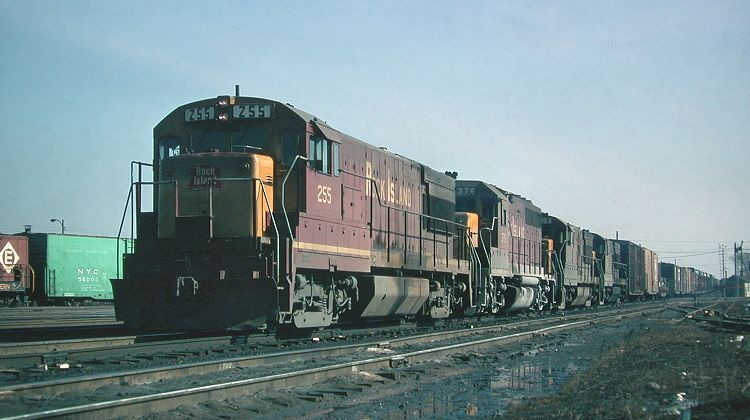Sugar Beet extras and Rice yard in Tales of the Jointed Track
- May 24, 2015, 6:46 p.m.
- |
- Public
You never knew when the Beet extras would start coming in. There was a sugar factory in Johnstown, Co and in Loveland / Longmont area.
The Rock Island would bring them in with a rag tag consists, some running, some dead, some overheated, and the hoppers used to load up with beets were not much better. The C&S would take them up to the GW railroad, ( Great Western) which was a short line that served the factories up there.

A Rock Island consist, better power, but visual.
If you get or buy, GW sugar, that’s where it came from. The GW sugar company owned the railroad at one time. It is now a private entity now.
Sometimes the beets would fall out of the hoppers due to overloading or maybe one of the cars ( like a wood outside braced hopper ) would have a hole in the side and some would fall out. There is nothing like the smell of rotting sugar beets, or spilled grain for that matter, out in the yard wafting through the air.
We were asked to assemble another consist for another beet turn. Two SD-9’s, were brought over from the 23rd St Roundhouse, from federal inspection and were part of the consist, plus 2 high horsepower units a GP 40 and an SD-40. The GP-40 and the SD-40 were placed on each end and the SD-9’s were spliced in the middle. At that time the train would probably be 50 to 60 cars and roughly 5000 to 5300 tons. After delivering to the GW, they may come back lite power or bring an empty train back to Rice yard.
We air tested the consist, and sent it over for fuel and sand. Also the units were checked for oil and water levels, and the cabs cleaned on each end. It was ordered for 500 am and away it went, or so we thought. We did our usual finishing up on the goats, carded out and changed the operating ends on a Santa Fe consist, and went home at the end of the shift.
During the trip to Loveland, CO one of the SD-9’s had a catastrophic engine failure. One of the piston and rod assemblies breached the liner, and the air box hatch.. and buckled the hood door. Now covered in oil dead in consist. They had to double Church’s Lake Hill. That was delaying the inbound train 78 at Boulder.
So when we came into work..Roger said. “Well get ready M.I. is going to ask about that failure. I told Roger, “ Hey was out of inspection at 23rd St. the water and oil levels were checked. No unusual sounds were noted, nor was a knocking or rapping coming from the diesel itself. Most likely a component failure while the engine was under load, but 23rd St would have to look at the problem.
Well sure enough, M.I. Smith was going to get to the bottom of this failure. I told him the same thing I told Roger Bell the foreman. Surely we noted something. Unusual sounds, odor, was it idling smoothly? Water and oil were those checked? YES, it was, the oil was hot and black and no signs of fouling or contamination. Water level was at the proper level and they had just added Borate to tank. The water in the sight glass was a clear reddish purple, with no signs of contamination. The Borate solution is a rust inhibitor. The locomotives have about 190 to 300 gallons of water, depending on the model, and do not have antifreeze. If the unit is shut down during freezing weather the cooling system is drained.
The unit was taken back to 23rd ST and repaired. I never found out what the reason for the failure was, and if M.I. knew, he never told us or figured we didn’t need to know.



Loading comments...